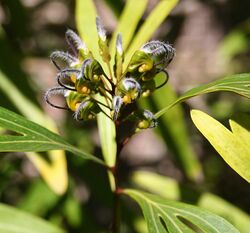Biology:Grevillea venusta
| Grevillea venusta | |
|---|---|

| |
| Young inflorescence | |
| Scientific classification | |
| Kingdom: | Plantae |
| Clade: | Tracheophytes |
| Clade: | Angiosperms |
| Clade: | Eudicots |
| Order: | Proteales |
| Family: | Proteaceae |
| Genus: | Grevillea |
| Species: | G. venusta
|
| Binomial name | |
| Grevillea venusta | |
Grevillea venusta, commonly known as Byfield spider flower,[3] is species of flowering plant in the family Proteaceae and is endemic to a small region of central eastern Queensland. It is an erect shrub with simple and/or divided leaves, the leaves or lobes narrowly oblong to narrowly elliptic, and clusters of green and yellow flowers with a deep maroon to purplish black style covered with white hairs.
Description
Grevillea venusta is a large, erect, rounded shrub that typically grows to 4 m (13 ft), or may reach 5 m (16 ft) high and wide, and has branchlets that are brownish and hairy. The leaves are 35–190 mm (1.4–7.5 in) long and 5–20 mm (0.20–0.79 in) wide, sometimes divided with 2 to 7 lobes, the leaves or lobes narrowly elliptic to narrowly oblong. The lower surface of the leaves is silky-hairy. The flowers are borne in loose or more or less cylindrical clusters of 12 to 20 on the ends of branches or in leaf axils on a rachis 50–90 mm (2.0–3.5 in) long. The flowers are rich green and yellow to orange with a deep maroon to purplish black style covered with white hairs, the pistil 30–36 mm (1.2–1.4 in) long. Flowers occurs throughout the year with a peak from June to September and the fruit is a greenish, elliptic, shaggy-hairy follicle 16–19 mm (0.63–0.75 in) long.[4][5][6][7]
Taxonomy
Grevillea venusta was first formally described in 1811 by Robert Brown in Transactions of the Linnean Society of London, after he collected the type specimen near Cape Townshend (near Shoalwater Bay) in eastern Queensland in August 1802.[8][9] The specific epithet is derived from the Latin venustus "charming, lovely or graceful".[10]
Distribution and habitat
Byfield spider flower is restricted to central eastern Queensland where it grows in forest and woodland in rocky places and along creeks between the Many Peaks Range and Shoalwater Bay. It occurs in Byfield and Castle Tower National Parks and the Shoalwater Bay Military Training Area.[3][4][5][7]
Conservation status
Grevillea venusta is listed as "vulnerable" under the Australian Government Environment Protection and Biodiversity Conservation Act 1999 and the Queensland Government Nature Conservation Act 1992.[1][7]
Use in horticulture
This species has been cultivated since the early 1970s and is suitable for use in small gardens, where it grows readily in a sunny position with good drainage. It is fast growing and hardy in a sunny, frost-free position.[3][4][6]
References
- ↑ Jump up to: 1.0 1.1 "Species Profile and Threats Database Greville venusta". Australian Government Department of Climate Change, Energy, the Environment and Water. http://www.environment.gov.au/cgi-bin/sprat/public/publicspecies.pl?taxon_id=7960.
- ↑ "Grevillea venusta". Australian Plant Census. https://biodiversity.org.au/nsl/services/apc-format/display/68229.
- ↑ Jump up to: 3.0 3.1 3.2 Clarke, Dan. "Grevillea venusta". Australian Plants Society, New South Wales. https://resources.austplants.com.au/plant/grevillea-venusta/.
- ↑ Jump up to: 4.0 4.1 4.2 Olde, Peter M.; Marriott, Neil R. (1995). The Grevillea Book. 2. Sydney: Kangaroo Press. p. 218. ISBN 978-0864173263.
- ↑ Jump up to: 5.0 5.1 "Grevillea venusta". Australian Biological Resources Study, Department of Agriculture, Water and the Environment: Canberra. https://profiles.ala.org.au/opus/foa/profile/Grevillea%20venusta.
- ↑ Jump up to: 6.0 6.1 Wrigley, John W.; Fagg, Murray A. (1991). Banksias, waratahs & grevilleas : and all other plants in the Australian Proteaceae family. North Ryde, NSW, Australia: Angus & Robertson. p. 346. ISBN 0207172773.
- ↑ Jump up to: 7.0 7.1 7.2 "Species profile—Grevillea venusta". Queensland Government Department of Environment and Science. https://apps.des.qld.gov.au/species-search/details/?id=13207.
- ↑ "Grevillea venusta". APNI. https://id.biodiversity.org.au/instance/apni/477089.
- ↑ Brown, Robert (1810). "On the Proteaceae of Jussieu.". Transactions of the Linnean Society of London 10 (1): 175. https://www.biodiversitylibrary.org/item/13720#page/183/mode/1up. Retrieved 11 April 2023.
- ↑ Simpson DP (1979). Cassell's Latin Dictionary (5 ed.). London: Cassell Ltd.. pp. 883. ISBN 0-304-52257-0.
Wikidata ☰ Q3009673 entry
 |


